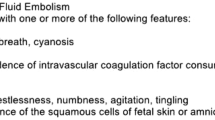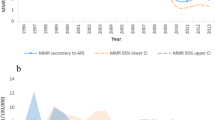Abstract
Purpose
Amniotic fluid embolism (AFE) is an unpredictable and unpreventable complication of maternity. The presentation may range from relatively subtle clinical events to sudden maternal cardiac arrest. However, the neglected diagnosis of non-classical form of AFE (atypical AFE) is very common. The aim of this study was to examine population-based regional data from Suzhou, China. Based on the analysis of all available case reports, we put forward an outline of atypical AFE and investigate whether any variation identified could be ascribed to methodology.
Methods
Retrospective study from January 2004 to December 2013, 53 cases was identified from the database of Center for Disease Control (CDC) in the city of Suzhou. We investigated the presentations of atypical AFE and maternal characteristics with potential factors underlying AFE. Multiple-regression analysis was used to calculate adjusted odds ratios (ORs) and 95 % confidence intervals (CIs).
Results
The incidence of AFE was 6.91 per 100,000 deliveries (53/766,895). Seventeen deaths occurred, a mortality rate of 32 %. Atypical AFE may as the earlier stage or mild form of AFE, there was no death case in the study with timely remedy. The atypical AFE appear is obstetric hemorrhage and/or pulmonary and renal dysfunction postpartum. Hyperfibrinolysis and coagulopathy may the early laboratory findings of atypical AFE. Atypical and classical AFE shared the same risks, such as advanced maternal age, placental abnormalities, operative deliveries, eclampsia, cervical lacerations, and induction of labor.
Conclusion
Staying alert to premonitory symptoms of AFE is critical to turn it to a remediable disease. Patient complaints such as breathlessness, chest pain, feeling cold, distress, panic, a feeling of nausea, and vomiting should elicit close attention. The management of a suspected episode of amniotic fluid embolism is generally considered to be supportive. Hysterectomy must be performed if there is further progression of symptoms. Due to advances in acute care, mortality has decreased in recent years, highlighting the importance of early detection and treatment.
Similar content being viewed by others
References
Clark SL (2010) Amniotic fluid embolism. Clin Obstet Gynecol 53(2):322–328. doi:10.1097/GRF.0b013e3181e0ead2
Conde-Agudelo A, Romero R (2009) Amniotic fluid embolism: an evidence-based review. Am J Obstet Gynecol 201 (5):445 e441–e413. doi:10.1016/j.ajog.2009.04.052
Kahyaoglu I, Kahyaoglu S, Mollamahmutoglu L (2009) Factor VIIa treatment of DIC as a clinical manifestation of amniotic fluid embolism in a patient with fetal demise. Arch Gynecol Obstet 280(1):127–129. doi:10.1007/s00404-008-0857-3
Yang W, Zhou N, Zhou Y (2000) The clinical analysis of 38 cases with amniotic fluid embolism. Zhonghua fu chan ke za zhi 35(2):75–78
Prosper SC, Goudge CS, Lupo VR (2007) Recombinant factor VIIa to successfully manage disseminated intravascular coagulation from amniotic fluid embolism. Obstetr Gynecol 109(2 Pt2):524–525. doi:10.1097/01.AOG.0000235711.11817.8c
Martin RW (1996) Amniotic fluid embolism. Clin Obstet Gynecol 39(1):101–106
Margarson MP (1995) Delayed amniotic fluid embolism following caesarean section under spinal anaesthesia. Anaesthesia 50(9):804–806
Yang CY, Chou CW, Lin MB, Lin CN, Wang LW, Chen SY, Cheng HM (2004) Recurrent pulmonary embolism in an elderly patient with Cushing’s syndrome, adrenocortical adenoma, pheochromocytoma and prostate adenocarcinoma. J Chin Med Assoc JCMA 67(7):360–365
Clark SL, Hankins GD, Dudley DA, Dildy GA, Porter TF (1995) Amniotic fluid embolism: analysis of the national registry. Am J Obstetr Gynecol 172(4 Pt 1):1158–1167 discussion 1167–1159
Nakagami H, Kajihara T, Kamei Y, Ishihara O, Kayano H, Sasaki A, Itakura A (2014) Amniotic components in the uterine vasculature and their role in amniotic fluid embolism. J Obstetr Gynaecol Res. doi:10.1111/jog.12650
Chen KB, Chang SS, Tseng YL, Chiu TH, Liao CC, Ho M, Huang GS, Li CY (2013) Amniotic fluid induces platelet-neutrophil aggregation and neutrophil activation. Am J Obstetr Gynecol 208(4):318 e311–317. doi:10.1016/j.ajog.2013.01.012
Benson MD (2012) Current concepts of immunology and diagnosis in amniotic fluid embolism. Clin Dev Immunol 2012:946576. doi:10.1155/2012/946576
Kanayama N, Inori J, Ishibashi-Ueda H, Takeuchi M, Nakayama M, Kimura S, Matsuda Y, Yoshimatsu J, Ikeda T (2011) Maternal death analysis from the Japanese autopsy registry for recent 16 years: significance of amniotic fluid embolism. J Obstetr Gynaecol Res 37(1):58–63. doi:10.1111/j.1447-0756.2010.01319.x
Davies S (1999) Amniotic fluid embolism and isolated disseminated intravascular coagulation. Can J Anaesth Journal canadien d’anesthesie 46 (5 Pt 1):456–459. doi:10.1007/BF03012944
Clark SL, Pavlova Z, Greenspoon J, Horenstein J, Phelan JP (1986) Squamous cells in the maternal pulmonary circulation. Am J Obstet Gynecol 154(1):104–106
Knight M, Tuffnell D, Brocklehurst P, Spark P, Kurinczuk JJ, System UKOS (2010) Incidence and risk factors for amniotic-fluid embolism. Obstet Gynecol 115(5):910–917. doi:10.1097/AOG.0b013e3181d9f629
Taylor FB, Jr., Toh CH, Hoots WK, Wada H, Levi M, Scientific Subcommittee on Disseminated Intravascular Coagulation of the International Society on T, Haemostasis (2001) Towards definition, clinical and laboratory criteria, and a scoring system for disseminated intravascular coagulation. Thromb Haemost 86 (5):1327–1330
Lurie S, Feinstein M, Mamet Y (2000) Disseminated intravascular coagulopathy in pregnancy: thorough comprehension of etiology and management reduces obstetricians’ stress. Arch Gynecol Obstet 263(3):126–130. doi:10.1007/s004040050010
Phillips LE, McLintock C, Pollock W, Gatt S, Popham P, Jankelowitz G, Ogle R, Cameron PA, Australian New Zealand, Haemostasis R (2009) Recombinant activated factor VII in obstetric hemorrhage: experiences from the Australian and New Zealand Haemostasis Registry. Anesth Analg 109(6):1908–1915. doi:10.1213/ANE.0b013e3181c039e6
Knight M, Fitzpatrick K, Kurinczuk JJ, Tuffnell D (2012) Use of recombinant factor VIIa in patients with amniotic fluid embolism. Anesthesiology 117(2):423. doi:10.1097/ALN.0b013e31825b6c77 author reply 423–424
Acknowledgments
We thank the cooperation and support from Women and Children’s Hospital of Suzhou city.
Conflict of interest
We declare that we have no conflict of interest.
Author information
Authors and Affiliations
Corresponding author
Rights and permissions
About this article
Cite this article
Shen, F., Wang, L., Yang, W. et al. From appearance to essence: 10 years review of atypical amniotic fluid embolism. Arch Gynecol Obstet 293, 329–334 (2016). https://doi.org/10.1007/s00404-015-3785-z
Received:
Accepted:
Published:
Issue Date:
DOI: https://doi.org/10.1007/s00404-015-3785-z




